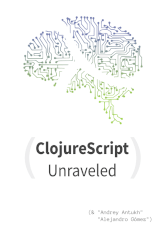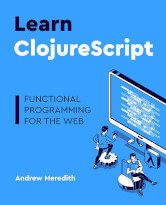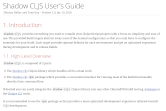Last Updated on May 22, 2022
ClojureScript is a compiler for Clojure that targets JavaScript. It emits JavaScript code which is compatible with the advanced compilation mode of the Google Closure optimizing compiler.
Clojure is a dialect of the Lisp programming language. It’s a well-rounded language. It offers broad library support and runs on multiple operating systems. Clojure is a dynamic functional general purpose programming language that runs on the Java platform, combining the approachability and interactive development of a scripting language with an efficient and robust infrastructure for multi-threaded programming. Clojure features a rich set of immutable, persistent data structures, first-class functions and dynamic typing. Clojure programs are composed of expressions and written in terms of abstractions.
Your starting point to learn Clojure is the official documentation. But here’s 3 free books that will help you master ClojureScript.
1. ClojureScript Unraveled (2nd edition) by Andrey Antukh and Alejandro Gómez
 ClojureScript Unraveled is an open source book about the ClojureScript language that covers all the language features, how to use the compiler and the tooling for building applications and libraries. It doesn’t assume experience with functional programming or any Lisp dialect and it serves both as a thorough introduction full of examples and as a reference of the language features for the seasoned ClojureScript developer.
ClojureScript Unraveled is an open source book about the ClojureScript language that covers all the language features, how to use the compiler and the tooling for building applications and libraries. It doesn’t assume experience with functional programming or any Lisp dialect and it serves both as a thorough introduction full of examples and as a reference of the language features for the seasoned ClojureScript developer.
Since the ClojureScript documentation is good but sparse, the authors wanted to write a compendium of reference information and extensive examples to serve as a ClojureScript primer as well as a series of practical how-to’s. This document will evolve with the ClojureScript language, both as a reference of the language features and as a sort of cookbook with practical programming recipes.
2. Learn ClojureScript by Andrew Meredith
 Whether you are an experienced JavaScript developer or a brand-new programmer, this book is your guide to creating impressive web apps in the simple and elegant ClojureScript language.
Whether you are an experienced JavaScript developer or a brand-new programmer, this book is your guide to creating impressive web apps in the simple and elegant ClojureScript language.
The tutorial-style lessons are easy to follow at your own pace, and the practical capstone projects will reinforce what you have learned.
3. Shadow CLJS User’s Guide by Thomas Heller and Tony Kay
 shadow-cljs provides everything you need to compile your ClojureScript projects with a focus on simplicity and ease of use.
shadow-cljs provides everything you need to compile your ClojureScript projects with a focus on simplicity and ease of use.
The provided build targets abstract away most of the manual configuration so that you only have to configure the essentials for your build.
Each target provides optimal defaults for each environment and get an optimized experience during development and in release builds.
All books in this series:
| Free Programming Books | |
|---|---|
| Ada | ALGOL-like programming language, extended from Pascal and other languages |
| Agda | Dependently typed functional language based on intuitionistic Type Theory |
| Arduino | Inexpensive, flexible, open source microcontroller platform |
| Assembly | As close to writing machine code without writing in pure hexadecimal |
| Awk | Versatile language designed for pattern scanning and processing language |
| Bash | Shell and command language; popular both as a shell and a scripting language |
| BASIC | Beginner’s All-purpose Symbolic Instruction Code |
| C | General-purpose, procedural, portable, high-level language |
| C++ | General-purpose, portable, free-form, multi-paradigm language |
| C# | Combines the power and flexibility of C++ with the simplicity of Visual Basic |
| Clojure | Dialect of the Lisp programming language |
| ClojureScript | Compiler for Clojure that targets JavaScript |
| COBOL | Common Business-Oriented Language |
| CoffeeScript | Transcompiles into JavaScript inspired by Ruby, Python and Haskell |
| Coq | Dependently typed language similar to Agda, Idris, F* and others |
| Crystal | General-purpose, concurrent, multi-paradigm, object-oriented language |
| CSS | CSS (Cascading Style Sheets) specifies a web page’s appearance |
| D | General-purpose systems programming language with a C-like syntax |
| Dart | Client-optimized language for fast apps on multiple platforms |
| Dylan | Multi-paradigm language supporting functional and object-oriented coding |
| ECMAScript | Best known as the language embedded in web browsers |
| Eiffel | Object-oriented language designed by Bertrand Meyer |
| Elixir | Relatively new functional language running on the Erlang virtual machine |
| Erlang | General-purpose, concurrent, declarative, functional language |
| F# | Uses functional, imperative, and object-oriented programming methods |
| Factor | Dynamic stack-based programming language |
| Forth | Imperative stack-based programming language |
| Fortran | The first high-level language, using the first compiler |
| Go | Compiled, statically typed programming language |
| Groovy | Powerful, optionally typed and dynamic language |
| Haskell | Standardized, general-purpose, polymorphically, statically typed language |
| HTML | HyperText Markup Language |
| Icon | Wide variety of features for processing and presenting symbolic data |
| J | Array programming language based primarily on APL |
| Java | General-purpose, concurrent, class-based, object-oriented, high-level language |
| JavaScript | Interpreted, prototype-based, scripting language |
| Julia | High-level, high-performance language for technical computing |
| Kotlin | More modern version of Java |
| LabVIEW | Designed to enable domain experts to build power systems quickly |
| LaTeX | Professional document preparation system and document markup language |
| Lisp | Unique features - excellent to study programming constructs |
| Logo | Dialect of Lisp that features interactivity, modularity, extensibility |
| Lua | Designed as an embeddable scripting language |
| Markdown | Plain text formatting syntax designed to be easy-to-read and easy-to-write |
| Objective-C | Object-oriented language that adds Smalltalk-style messaging to C |
| OCaml | The main implementation of the Caml language |
| Pascal | Imperative and procedural language designed in the late 1960s |
| Perl | High-level, general-purpose, interpreted, scripting, dynamic language |
| PHP | PHP has been at the helm of the web for many years |
| PostScript | Interpreted, stack-based and Turing complete language |
| Prolog | A general purpose, declarative, logic programming language |
| PureScript | Small strongly, statically typed language compiling to JavaScript |
| Python | General-purpose, structured, powerful language |
| QML | Hierarchical declarative language for user interface layout - JSON-like syntax |
| R | De facto standard among statisticians and data analysts |
| Racket | General-purpose, object-oriented, multi-paradigm, functional language |
| Raku | Member of the Perl family of programming languages |
| Ruby | General purpose, scripting, structured, flexible, fully object-oriented language |
| Rust | Ideal for systems, embedded, and other performance critical code |
| Scala | Modern, object-functional, multi-paradigm, Java-based language |
| Scheme | A general-purpose, functional language descended from Lisp and Algol |
| Scratch | Visual programming language designed for 8-16 year-old children |
| SQL | Access and manipulate data held in a relational database management system |
| Standard ML | General-purpose functional language characterized as "Lisp with types" |
| Swift | Powerful and intuitive general-purpose programming language |
| Tcl | Dynamic language based on concepts of Lisp, C, and Unix shells |
| TeX | Markup and programming language - create professional quality typeset text |
| TypeScript | Strict syntactical superset of JavaScript adding optional static typing |
| Vala | Object-oriented language, syntactically similar to C# |
| VHDL | Hardware description language used in electronic design automation |
| VimL | Powerful scripting language of the Vim editor |
| XML | Rules for defining semantic tags describing structure ad meaning |
